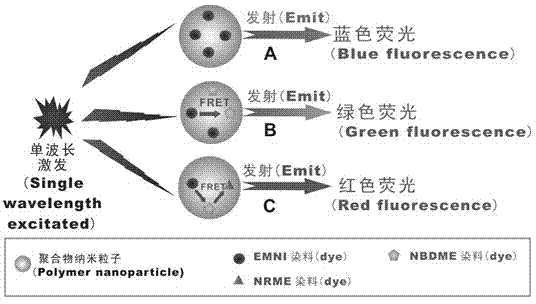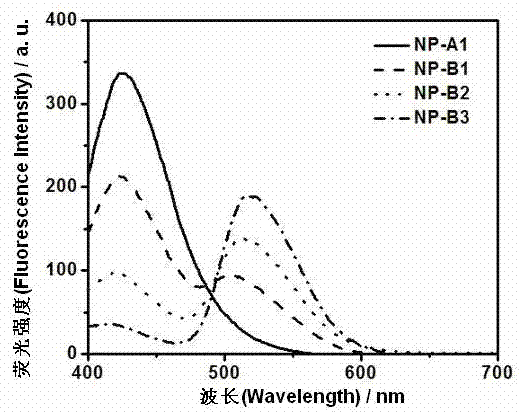Water-dispersible multicolour fluorescent polymer nanoparticles and preparation method thereof
A fluorescent polymer and nanoparticle technology, applied in chemical instruments and methods, luminescent materials, etc., can solve the problems of harsh synthesis conditions, unfavorable expansion of production and application, etc., achieve simple synthesis route, improve structure and photostability, and huge application. Foreground effect
- Summary
- Abstract
- Description
- Claims
- Application Information
AI Technical Summary
Problems solved by technology
Method used
Image
Examples
Embodiment 1
[0032] Example 1: Preparation of water-dispersible blank polymer nanoparticles (NP-00) by miniemulsion polymerization.
[0033] Stir the mixture of 0.625g methyl methacrylate and 0.059g n-hexadecane on an ordinary magnetic stirrer for 5 minutes to obtain solution A; meanwhile, add 0.025g of SDS to 10ml of water and stir on an ordinary magnetic stirrer Solution B was obtained in 10 minutes. After mixing solutions A and B, stir at room temperature for 15-20 minutes to form a pre-emulsion, put the pre-emulsion into a 650W power ultrasonic cell pulverizer in an ice-water bath (keep below 20°C), and ultrasonically emulsify for 15 minutes. A stable miniemulsion can be obtained. The miniemulsion was transferred into a 25ml round bottom flask, 0.022g potassium persulfate was added to initiate polymerization, and the round bottom flask was placed in a 75 oC oil bath for 3h. After the reaction, cool to room temperature, and simply filter to obtain the desired water-dispersible blank pol...
Embodiment 2
[0034] Example 2: Miniemulsion Polymerization Preparation of water-dispersible fluorescent polymer nanoparticles (NP-A1) containing a single EANI fluorescent dye.
[0035] Stir the mixture of 0.625g methyl methacrylate, 0.059g n-hexadecane and 0.00094g of EANI on a common magnetic stirrer for 5 minutes to obtain solution A; at the same time, add 0.025g of SDS to 10ml of water. Stir on a magnetic stirrer for 10 minutes to obtain solution B. After mixing solutions A and B, stir at room temperature for 15-20 minutes to form a pre-emulsion, put the pre-emulsion into a 650W power ultrasonic cell pulverizer in an ice-water bath (keep below 20°C), and ultrasonically emulsify for 15 minutes. A stable miniemulsion can be obtained. The miniemulsion was transferred into a 25ml round bottom flask, 0.022g potassium persulfate was added to initiate polymerization, and the round bottom flask was placed in a 75 oC oil bath for 3h. After the reaction, cool to room temperature, and simply fil...
Embodiment 3
[0036] Example 3: Miniemulsion polymerization preparation of water-dispersible multicolor fluorescent polymer nanoparticles (NP-B1, NP-B2 and NP-B3) containing different ratios of EANI and NBDAA fluorescent dyes.
[0037] 0.625g methyl methacrylate, 0.059g n-hexadecane, 0.00094g EANI, 0.00074g (corresponding to sample NP-B1) or 0.00148g (corresponding to sample NP-B2) or 0.00222g (corresponding to sample NP-B2) -B3) The NBDAA mixture was stirred on a common magnetic stirrer for 5 minutes to obtain solution A; at the same time, 0.025 g of SDS was added to 10 ml of water, and stirred on a common magnetic stirrer for 10 minutes to obtain solution B. After mixing solutions A and B, stir at room temperature for 15-20 minutes to form a pre-emulsion, put the pre-emulsion into a 650W power ultrasonic cell pulverizer in an ice-water bath (keep below 20°C), and ultrasonically emulsify for 15 minutes. A stable miniemulsion can be obtained. The miniemulsion was transferred into a 25ml ro...
PUM
| Property | Measurement | Unit |
|---|---|---|
| particle diameter | aaaaa | aaaaa |
Abstract
Description
Claims
Application Information
 Login to View More
Login to View More - R&D
- Intellectual Property
- Life Sciences
- Materials
- Tech Scout
- Unparalleled Data Quality
- Higher Quality Content
- 60% Fewer Hallucinations
Browse by: Latest US Patents, China's latest patents, Technical Efficacy Thesaurus, Application Domain, Technology Topic, Popular Technical Reports.
© 2025 PatSnap. All rights reserved.Legal|Privacy policy|Modern Slavery Act Transparency Statement|Sitemap|About US| Contact US: help@patsnap.com



